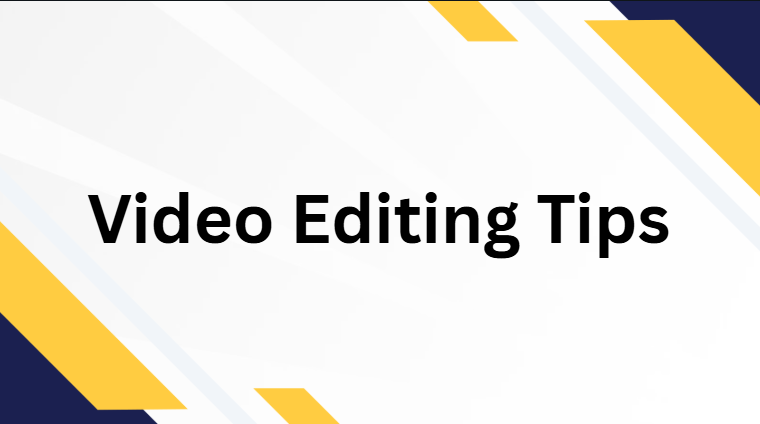Video editing is one of the most exciting and creative parts of making videos. Whether you are creating content for YouTube, social media, or a personal project, learning to edit well can make your videos look professional and engaging. In this article, we will cover simple and effective video editing tips that anyone can use — even beginners.
1. Understand the Basics of Video Editing
Before diving into fancy transitions or effects, it’s important to know the basics.
Video editing means cutting, trimming, joining, and arranging video clips to tell a story or share a message. The main goals are to keep the audience interested and deliver clear, smooth content.
Basic editing steps include:
- Importing your clips into an editing program
- Cutting out unwanted parts
- Adding background music or sound
- Using transitions to move between scenes
- Exporting your final video in the right format
2. Choose the Right Video Editing Software
Your choice of editing software can make a big difference.
For beginners, simple programs like iMovie, Filmora, or CapCut are easy to use.
If you want more control, try Adobe Premiere Pro, DaVinci Resolve, or Final Cut Pro.
Tips for choosing the right software:
- Pick one that matches your skill level
- Make sure it supports your computer system
- Check for built-in tutorials or help guides
Remember, you don’t need expensive software to make great videos — it’s all about creativity!
3. Keep Your Story Clear and Engaging
Every video tells a story. Even short clips on TikTok or Instagram have a beginning, middle, and end.
Before editing, plan what story you want to tell. Make sure your video flows naturally from one scene to the next.
Ask yourself:
- What is the main message of my video?
- Does each clip add something important?
- Is there a clear start and finish?
Good storytelling helps keep your viewers interested from start to end.
4. Trim and Cut Smartly
Cutting is one of the most powerful tools in video editing.
Remove boring or slow parts so that your video keeps moving.
Keep each clip short and focused on the key action.
Smart trimming tips:
- Avoid long pauses or repetitive scenes
- Keep transitions smooth
- Match the rhythm of your cuts with the music or narration
A fast, clean edit will make your video feel more professional.
5. Use Music and Sound Wisely
Sound is half of the video experience. Background music, sound effects, and voiceovers can change how viewers feel.
Always choose music that fits your video’s mood — upbeat for fun content or calm for emotional scenes.
Important sound editing tips:
- Make sure music doesn’t overpower voices
- Use copyright-free music (like from YouTube Audio Library or Pixabay)
- Add small sound effects to make actions feel real
Clear sound can turn a simple video into something amazing.
6. Add Simple Transitions and Effects
Transitions help move from one scene to another smoothly. But don’t overuse them — too many effects can distract your audience.
Good transition ideas:
- Fade in and fade out for smooth scene changes
- Cross dissolve for blending clips
- Cut on action for a natural flow
Use filters or color correction to improve the look of your video, but keep it natural.
7. Focus on Good Lighting and Color
Lighting can make or break your video. If your clips are too dark or too bright, they’ll look unprofessional.
Try adjusting brightness, contrast, and color balance in your editing software.
Pro tip:
Use “color grading” to give your video a unique style. For example, warm tones for travel vlogs or cool tones for tech videos.
8. Add Text and Captions
Text can help highlight key points, introduce scenes, or add subtitles for viewers who can’t use sound.
Make sure your text is easy to read and matches your video’s theme.
Tips for adding text:
- Use simple fonts
- Keep it short and visible for 3–5 seconds
- Place it where it doesn’t cover the main subject
Adding captions also improves accessibility and helps your videos reach more people.
9. Export in the Right Format
Once your video is ready, export it in the right format and resolution.
For YouTube or online platforms, MP4 with 1080p quality is a safe choice.
Check before exporting:
- The resolution (720p, 1080p, or 4K)
- The frame rate (usually 24, 30, or 60 fps)
- The file size — make sure it’s not too large for uploading
Proper exporting keeps your video quality high and playback smooth.
10. Keep Practicing and Learning
The best editors didn’t learn everything in one day. The more you practice, the better you’ll get.
Watch tutorials, experiment with new techniques, and get feedback from others.
Over time, you’ll develop your own editing style and workflow.
FAQs
1. What is the easiest video editing software for beginners?
Apps like iMovie, Filmora, and CapCut are great for beginners because they have simple tools and user-friendly interfaces.
2. How can I make my videos look more professional?
Focus on good lighting, smooth transitions, clear sound, and strong storytelling. Even basic edits can look professional if done cleanly.
3. What’s the best format to export videos for YouTube?
Use MP4 format with 1080p resolution and 30 fps for the best balance of quality and file size.
4. How long does it take to learn video editing?
You can learn the basics in a few weeks, but becoming really skilled takes time and practice. Keep experimenting and watching tutorials.
5. Can I edit videos on my phone?
Yes! Mobile apps like CapCut, InShot, and VN Video Editor let you edit videos easily right from your phone.
Conclusion
Video editing is not just about cutting and adding effects — it’s about telling a story that connects with your audience. With the right tools, a clear plan, and regular practice, anyone can become a skilled video editor. Start small, keep it simple, and improve with every project.
